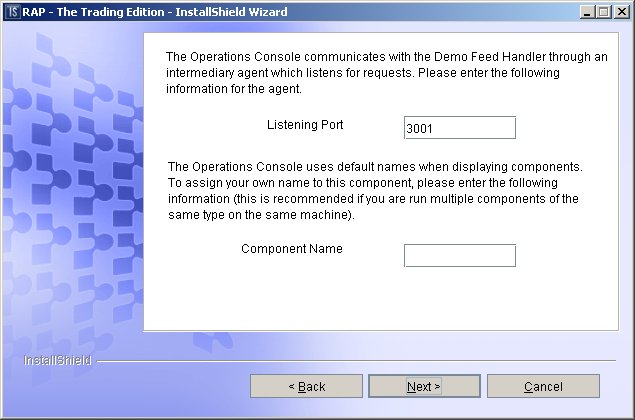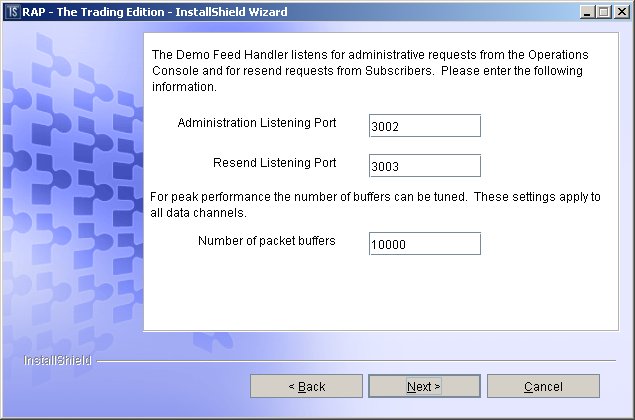The Demo Feed Handler configuration dialogs allow you to set the UAF agent listening port and UAF agent component name, identify data channels to be used to multicast messages, set listening ports, set performance options and identify the JINI Server Host Name.
Demo Feed Handler configuration dialog 1
Operations Console communicates with the Demo Feed Handler through an intermediary agent. Use this dialog to set the UAF agent listening port and optional UAF agent component name.

|
Field name |
Default value |
Description |
|---|---|---|
|
Listening Port |
3001 |
Identifies the listening port that the UAF agent uses to communicate with Operations Console. You can use any free port on your system. |
|
Component Name |
None |
Identifies this component. This name provides an identity that distinguishes this component from other components of the same type. Projects may include several subscribers or publishers. Assign unique names to components to easily track them. |
Demo Feed Handler configuration dialog 2
Demo Feed Handler multicasts messages to subscribers over one or more data channels. Four channels are recommended for a system that handles 300,000 messages per second. Use this dialog to identify the data channels.

Demo Feed Handler configuration dialog 3
Demo Feed Handler listens for administrative requests from Operations Console and resend requests from subscribers. Use this dialog to set different listening ports and performance options.

|
Field name |
Default value |
Description |
|---|---|---|
|
Administration Listening Port |
3002 |
Identifies the listening port that the publisher uses to monitor administrative requests from Operations Console. |
|
Resend Listening Port |
3003 |
Identifies the port that the publisher uses to resend cached message packets to the subscriber. Publishers maintain a cache of recently sent message packets to ensure that the subscriber processes all message deliveries. |
|
Number of Packet Buffers |
10000 |
Identifies the number of packet buffers. The publisher holds onto arriving packets of messages until the packets are processed. The number of packet buffers is per data stream. This setting can have a value between 1 and 4 billion, but the machine must have enough memory to hold the number of packets specified. Adjust this setting if resend requests from publishers are failing, because the packet no longer exists. For publishers, a value of 10000 will usually provide sufficient packet history to maintain data integrity under moderate loads. |
Demo Feed Handler configuration dialog 4
Installing Operations Console also installs a JINI server that tracks RAP components. This dialog prompts you for the JINI server host name, which is the same host machine where you install Operations Console.You must identify the JINI Server Host Name to register Demo Feed Handler with the JINI Server.

|
Field name |
Description |
|---|---|
|
JINI Server Host Name |
Identifies the host name of the server where the RAP JINI server resides. This is the machine on which Operations Console is installed. You must identify the JINI Server Host Name to register this component with the JINI Server. |